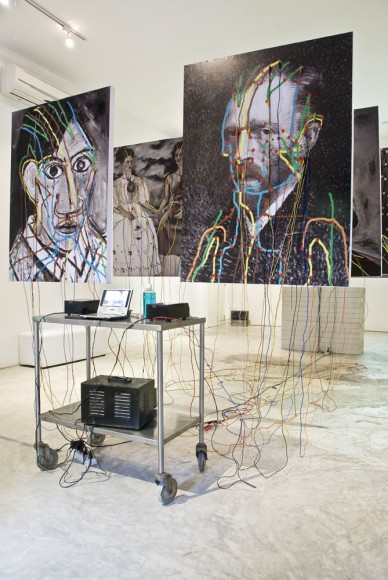


Chaisiri Jiwarangsan + Prapat Jiwarangsan: Healing
SOL Gallery, Bangkok (www.solbkk.com)
April 24 – May 24, 2009
They say the boundary between art and psychosis is a very thin line. Sometimes, the line is so thin that it starts to blur and enables both artists and psychopaths to traffic unhindered.
This says a lot about why I find many top-notch artists sometimes (or most of the times) a little insane, and why I believe that we (artists, writers or anyone interested in the art world) sometimes question ourselves whether what we do is a matter of creativity or is related to the fact that deep down we need something to work out what’s wrong inside our head.
Perhaps, that is why it is love at first sight with‘Artists sick’, the photo installation by Prapat Jiwarangsan exhibited at SOL gallery. The artist comes from a Chinese family that ran a traditional Chinese medicine business. Prapat who found acupuncture an effective treatment for his allergy wanted to extend its therapeutic benefits to other artists who suffered from both physical and psychological illnesses. The video piece narrates Prapat bringing re-produced self-portraits of well known artists to an acupuncturist and asking him to heal them.

Hilarity ensues when Prapat explains the illnesses of his ‘patients’ to the doctor with the help of a translator, “he (Picasso) was suffering from respiratory problem, causing by too much smoking”, or “this guy (Van Gogh) was depressed”; the doctor then appears to be obligingly pinning the acupuncture needles onto the paintings. An ironic moment when we consider the idea of art as ameliorative or cathartic but in this instance, the artists require curing themselves!
Finally, Prapat enlarged the artists’ self-portraits and painted dots on the acupunctural spots suggested by the doctor. Some dots on the paintings were attached with pins and colorful cords. This where Van Gogh, Picasso, Warhol, Kahlo, Bacon, Pollock, Kusuma and Prapat himself received treatment through their portraits.

‘Artists Sick’ is a part of a two man exhibition titled ‘Healing’, and it is accompanied Chaisiri Jiwarangsan’s ‘Unforgettable’. The series consists of two photo installation and a video piece. My favourite piece is one of the photo installation that is comprised of 3 photographs. The photograph placed in the middle is made to look so old that it becomes hard to tell who the person being photographed is, while the other two are portraits of different women. The idea of this work came to Chaisiri when he discovered a crumpled piece of aged photograph in his father’s wallet and was told that it is a picture of his grandmother. Since it is almost impossible to identify his grandmother from the picture, Chaisiri allowed a restorer to digitally re-imagine two different versions of what they could make out from the photo.

Two other works by Chaisiri also explored the concept of memory. In the other photo installation, Chaisiri showed juxtapose two images showing two different locales. The first one is an image of a stadium which has since been turned into a university where Chaisiri did his tertiary studies. The second photo depicts an elementary school located near where he lived but he had neither studied there nor explored its compound. So while he has a lot of memories attached to the old stadium, he has none associated with the elementary school. Chaisiri then developed this idea into a pendent video installation where he invited people to fill the empty space inside the school with stories, and then edited the video so that the narratives flow like a stream of consciousness.

Honestly, after spending a short while trying to find out the story in that piece, I ended up with nothing. Then it struck me that perhaps grappling with the fluidity and ambiguity of memory is a form of mental illness. If what I have thought is true, perhaps next times Prapat should take his brother to the acupuncturist.
… And if the needle job works this time, please give me a number of that acupuncturist!
~
Photos by Pongpon Yuttharat
Tunyaporn Hongtong writes for Art4D, a bilingual art and design magazine based in Bangkok
Sorry, the comment form is closed at this time.
A STanford anthropologist powers through a 90 minute lecture on the link between schizotypal personality, OCD behavior and religion.
http://blip.tv/file/2204956/
Some ideas within can be associated with the perception of the artist as madman/ shaman.
Thanks, Daniel. will check it out!